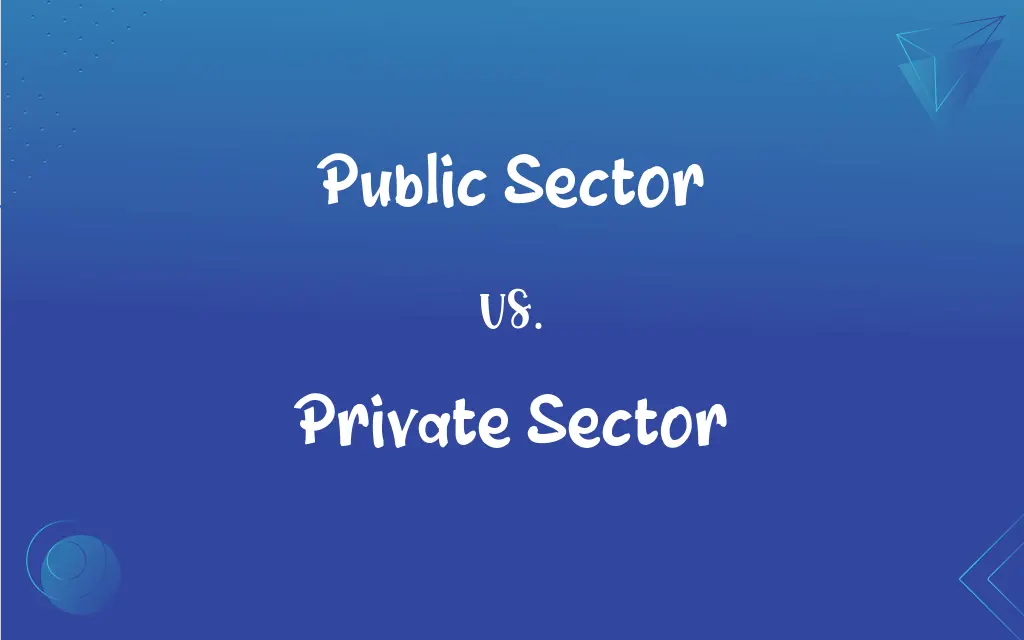Public Sector vs. Private Sector: What's the Difference?
Edited by Janet White || By Harlon Moss || Updated on October 4, 2023
The public sector is governed by state or federal entities and serves public interests, while the private sector consists of businesses and organizations driven by individual or corporate interests and profits.

Key Differences
The public sector is essentially a segment of the economy where goods and services are provided by government agencies and organizations. These entities, within the public sector, are funded mainly through taxation and are primarily focused on serving the general public. Conversely, the private sector encompasses businesses, corporations, and entities that are privately owned and operated, working primarily for profit.
When considering ownership, the public sector is under the domain of state, federal, or municipal governments. This includes institutions such as public schools, post offices, and government agencies. The private sector, on the other hand, comprises entities that are owned by individuals, groups, or shareholders. These could range from small local businesses to large multinational corporations.
In terms of primary objectives, the public sector often emphasizes public welfare and aims to provide services that benefit society as a whole, irrespective of profitability. The private sector, being profit-driven, usually bases its decisions and operations on market demands and potential for monetary gains.
The public sector often has broader accountability, having to answer to the citizenry, ensure transparency, and adhere to regulations and public policies. In contrast, the private sector's accountability largely revolves around its shareholders, investors, and the market, and it tends to prioritize efficiency and innovation in its operations.
Accountability in the public sector is mainly towards the public and elected representatives, ensuring that the services provided meet societal needs and are in line with governmental regulations. The private sector, while also adhering to certain regulations, is primarily accountable to its owners and shareholders, aiming to maximize profitability.
ADVERTISEMENT
Comparison Chart
Ownership
Owned and operated by government entities.
Owned by individuals, groups, or shareholders.
Primary Objective
Public welfare and service.
Profit and market demands.
Examples
Public schools, post offices.
Small businesses, multinational corporations.
Accountability
To the general public and elected representatives.
To owners, shareholders, and the market.
Funding Sources
Primarily funded through taxation.
Earned through sales, investments, and services.
ADVERTISEMENT
Public Sector and Private Sector Definitions
Public Sector
The public sector serves the collective needs of society.
Public health organizations in the public sector aim to ensure community well-being.
Private Sector
The private sector is driven primarily by the aim to generate profits.
The private sector's restaurants often price items based on profit margins.
Public Sector
The public sector is funded mainly by taxpayer money.
State universities, being part of the public sector, rely significantly on state funding.
Private Sector
The private sector operates based on market demands.
Fashion brands in the private sector produce styles based on consumer trends.
Public Sector
The public sector emphasizes services over profitability.
Public transport, a facet of the public sector, often operates even when not profitable.
Private Sector
The private sector consists of businesses not operated by the government.
Companies like Apple and Google are giants in the private sector.
Public Sector
The public sector includes entities that adhere to governmental regulations.
In the public sector, public schools must follow state educational standards.
Private Sector
The private sector includes entities that compete for business.
In the competitive private sector, tech companies constantly innovate.
Public Sector
The public sector consists of organizations operated by the government.
The public sector includes entities like public libraries and police departments.
Private Sector
The private sector encompasses a wide range of industries and scales.
From local bakeries to global banks, all are part of the diverse private sector.
FAQs
What defines the private sector?
The private sector consists of privately-owned businesses and organizations aiming for profit.
Can a company operate in both sectors?
Typically, a company belongs to one sector, but there can be public-private partnerships.
How is the public sector funded?
Primarily through taxation.
How does the private sector generate income?
Through sales, services, and investments.
Why might someone choose to work in the public sector?
For job security, societal impact, or benefits.
Why might businesses prefer operating in the private sector?
For greater operational freedom and profit potential.
What is the public sector?
The public sector comprises government-operated organizations serving public interests.
Is job security higher in the public or private sector?
Generally, the public sector offers greater job security.
Can a public sector entity be sold to the private sector?
Yes, this process is termed privatization.
Is the public sector non-profit?
While not driven by profit, some entities may generate surpluses.
Can the private sector contribute to public welfare?
Yes, through corporate social responsibility and philanthropy.
Which sector is more efficient?
The private sector often emphasizes efficiency, but both sectors have their strengths.
How do objectives differ between the sectors?
The public sector emphasizes public welfare, while the private sector aims for profit.
Which sector is larger in size?
It varies by country; in some, the public sector dominates, while in others, the private sector is larger.
How does innovation differ between sectors?
The private sector tends to prioritize innovation due to market competition.
Why is the public sector necessary?
It provides essential services that may not be profitable for the private sector.
Are public sector employees government employees?
Yes, they work under government-operated entities.
Can the private sector influence the public sector?
Yes, through lobbying, partnerships, and policy recommendations.
Which sector typically offers higher salaries?
The private sector often has higher earning potential.
Do both sectors face regulation?
Yes, but the public sector often has more stringent regulatory oversight.
About Author
Written by
Harlon MossHarlon is a seasoned quality moderator and accomplished content writer for Difference Wiki. An alumnus of the prestigious University of California, he earned his degree in Computer Science. Leveraging his academic background, Harlon brings a meticulous and informed perspective to his work, ensuring content accuracy and excellence.
Edited by
Janet WhiteJanet White has been an esteemed writer and blogger for Difference Wiki. Holding a Master's degree in Science and Medical Journalism from the prestigious Boston University, she has consistently demonstrated her expertise and passion for her field. When she's not immersed in her work, Janet relishes her time exercising, delving into a good book, and cherishing moments with friends and family.































































